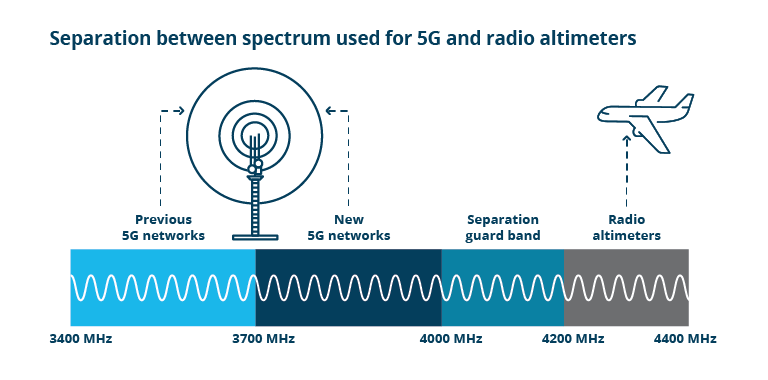We are working with the aviation industry and the Australian Communications and Media Authority (ACMA) to ensure flight safety during the expansion of the 5G network in Australia.
This includes steps to reduce potential interference from 5G to radio altimeters (radalts).
Get fitted to protect against 5G
You must upgrade radalts that do not meet specified requirements by March 31, 2026.
Radalt requirements
All radalts on affected aircraft must meet the interference tolerance requirements specified for a ‘radio altimeter tolerant airplane’. FAA Airworthiness Directive (AD) 2023-10-02 outlines these requirements.
The FAA AD specifies the tolerance levels radalts must have for radio frequency interference. This includes both within the radalt band of 4.2 to 4.4 GHz and outside this band.
Affected aircraft and instrument approach procedures
Aircraft that use the following instrument approach procedures must meet the requirements:
- Instrument Landing System Category II and III (ILS Cat II and III)
- Special Authorisation ILS Category I and II (SA ILS Cat I and II)
- Required Navigation Performance – Authorisation Required (RNP-AR) approaches.
Note: AIP DAP charts specifically label RNP-AR procedures as RNP-AR. They are different to the usual RNP approaches, previously called RNAV (GNSS) approaches in Australia.
We will continue to review other operations which require the use of radalts, such as some helicopter operations e.g. NVIS operations. We will engage with the industry before making any further changes.
Upgrading radalts
Aircraft operators should talk to their aircraft and equipment manufacturers to:
- discuss upgrade options
- arrange the purchase and fitment of new equipment, if your aircraft does not already meet the equipment requirements.
Many radalt manufacturers and aircraft type certificate holders are designing or offering upgraded systems to better handle interference from 5G. However, some old radalt systems which cannot be upgraded, or which are no longer supported, may need to be replaced.
Restrictions
If your aircraft does not meet the equipment requirements, you will not be able to fly the specified instrument approaches after 31 March 2026.
As of September 2024, the AIP publishes the specified instrument approach procedures for the following airports. If any new procedures, in the specified list, are published in AIP, you will also need a compliant radalt to fly the procedure after 31 March 2026.
- Avalon (Vic)
- Adelaide (SA)
- Alice Springs (NT)
- Ballina (NSW)
- Brisbane (Qld)
- Broome (WA)
- Cairns (Qld)
- Canberra (ACT)
- Darwin (NT)
- Gold Coast (Qld)
- Hamilton Island (Qld)
- Melbourne (Vic)
- Mount Isa (Qld)
- Norfolk Island
- Perth (WA)
- Sunshine Coast (Qld)
- Sydney (NSW)
- Townsville (Qld)
- Wellcamp (Qld)
Temporary airport mitigations
The Australian Communications and Media Authority (ACMA) has established measures to protect radalts from 5G transmissions until 31 March 2026.
The mitigations restrict 5G wireless broadband deployments in the 3.7 to 4.0 GHz band around runways and approaches at the listed airports.
We ask operators and pilots using radalts outside identified airports to check our:
This will help you understand how 5G transmissions might affect radalt performance.
Background
Pilots use radalts to measure an aircraft’s height above the ground. Other safety systems also depend on radalts, making them essential for some operations. This is especially true during final approach and landing in low visibility when crews rely on instruments.
In Australia, 4G and 5G have been operating in the nearby 3.4 to 3.7GHz band since 2016 and 2019 respectively. Radalts operate in the radio frequency band between 4.2 and 4.4 GHz. ACMA has allocated licences for new 5G operations in the 3.7 to 4.0 GHz spectrum.
diagram of 5G frequencies and the frequencies used by radalts.
There has been international concern about the impact of 5G transmissions on radalts. These impacts include:
- intermittent operation
- false measurements
- temporary loss of function.
Reporting issues
Report any issues you experience with new 5G wireless communications using our defect report service.
We would like you to report:
- occurrences at or below 2,500 ft AGL
- all incorrect radalt displays or indications during take-off and landing
- any aircraft system faults or failures caused by radalt inputs/data.
Refer to Airworthiness Bulletin AWB 34-020 for further details on what to report:
Operating overseas
United States
In the United States, the Federal Aviation Administration (FAA) has published airworthiness directives for 5G. These directives require certain types of aircraft to have radalts that meet minimum performance standards.
Australian aircraft operators that fly into the United States must follow the FAA rules. This includes upgrading equipment where required.
Other countries
Australian aircraft operators flying to other countries must follow the rules set by the local aviation authorities. These rules may differ from Australian regulations.


